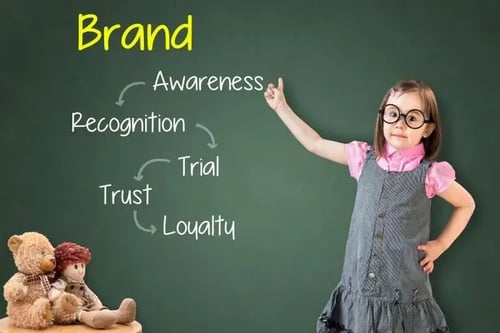Did you know that 93 percent of all purchase decisions are made subconsciously? That’s why brand awareness is sofalse
Most organisations use brand tracking as a way of continually monitoring the market and providing the data needed to guide decision making.
Brand tracking allows us to measure a range of brand health metrics that highlight the strengths and weaknesses and benchmark ourselves against the competition. We can also use a brand tracker to gather qualitative data to better understand how people think and feel about our brand.
If you are new to brand tracking and are setting up a monitor for the first time, we have put together a list of 10 brand health metrics to use as a starting point.
1. Brand Awareness:
Brand awareness is a key indicator of the health of a brand and on-going measurement can help determine the effectiveness of marketing activities. It is important to measure both aided and unaided brand awareness.
Aided brand awareness is used to determine whether an audience has any knowledge of a brand’s existence when prompting the brand’s name. Unaided brand awareness is a measure of the number of people who remember a brand without any visual or audio prompting.
First brand’s mentioned are a key indicator for likely purchase choice, as these are also likely to be the first brand’s thought of when a customer is making a purchase.
2. Brand Consideration:
Brand consideration is an important part of any marketing funnel. Consumers wouldn’t necessarily consider purchasing from every brand they are aware of.
Measuring consideration allows us to understand what proportion of the market our brand is an option for. We can also better understand our competitive set, i.e. for those people who consider us, who else would they also consider.
There could be a range of reasons why consumers who are aware of your brand are not considering it. It is important to ensure that your brand is targeting the right people and also the messages you are communicating via marketing activities are resonating with your target audience.

Brand preference measures how often you are the preferred choice for consumers when making a purchase. Brands that are well known and are consistently able to demonstrate their value over competitors will be chosen more often.
If you find your conversion is low, or lower than competitors, you need to ensure that you are communicating your unique selling points in a way that connects with consumers. Also look at what your competitors are doing, what is working for them and create a strategy to ensure you stand out from the crowd.
4. Brand Loyalty:

There are a number of ways of measuring customer loyalty towards your brand. One of the most well-known and popular methods is the Net Promoter Score (or NPS). NPS is a customer loyalty and satisfaction measurement which asks customers how likely they are to recommend a brand to friends or family.
NPS works by categorising people as either promoters, passives, or detractors of a brand. By subtracting the total number of detractors from the total number of promoters, we are able to calculate an NPS score (from -100 to +100).
NPS scores are used widely, across numerous industries and geographic locations. It is therefore a great option if you are looking to benchmark your brand’s performance against others.
5. Loyalty Reasoning:
Whilst it’s important to know and track customer loyalty, it is also useful to understand why customers feel the way they do. We can do this by asking them why they prefer or alternatively reject your brand.
Direct consumer feedback is critical in being able to not only solve business issues, but enabling a brand to identify core strengths and subsequently promote positive messages that encourage customers to be advocates for your brand.
6. Buzz or Attention:
Which brands have people heard something about (whether through the news, advertising or talking to friends and family). It is important to measure this frequently, to keep a finger on the pulse of the consumer.
It is also critical to identify whether the attention a brand has received is positive or negative.

7. Advertising Awareness:
By asking consumers where they have seen or heard about your brand, we can understand which channels are having the greatest impact.
For example, do consumers have high levels of awareness of your latest TV advertisement? Or is your social media campaign creating the buzz you expected?
It’s imperative to understand which marketing activities are having the greatest impact so you can make decisions and adjust your marketing strategy accordingly.

8. Brand Perception:
Consumers with a favourable perception of a brand are more likely to continue purchasing that brand and recommend their products to friends and family.
We can measure this by asking people if their perception of a brand has changed for the better or worse and measure this over time.
Creating a positive brand perception is key. If consumer perception declines, there is significant risk of increased customer churn.
9. Brand Attributes:
Defining and measuring attributes that are relevant to your industry, allows a brand to understand its DNA from a consumer perspective. And by asking consumers to associate attributes with a brand, we can see what sets our brand apart from the competition and can assist in brand positioning.
Measuring brand attributes can also inform the effectiveness of marketing activities and assist in planning future communication strategy.
10. Competitor Comparison:
How does your brand compare to the competition across a range of areas critical to your business success?
Comparing performance across a range of key areas allows a brand to identify opportunities and potential threats.
For example, if you have a perceived weakness in customer service, consumers may not be as loyal to your brand and more open to trying a competitor offering.
By measuring these and other important metrics, we are able to begin putting together a complete picture of our brand and the market we compete in. Of course, every organisation is different. It is important to ensure what you measure makes sense for your industry and customer.
If you are interested in discussing which metrics which will deliver the most value in growing your brand, get in touch today. We offer a free no obligation, brand research strategy session to all new clients.

Let us be your guide
Discover how Brand Health can help you unlock insights to drive your brand's growth!
Related posts
All brands try to be different from one another and create an identity that allows them to stand out from thefalse
Senior marketing executives know that a brand refresh – updating elements like the logo, packaging, and messaging – can reinvigorate afalse
Thursday 8:00 AM, Sydney. The marketing team at a top Australian retailer huddles around the latest brand health dashboard. Eyes widenfalse
Choosing the right market research agency makes all the difference between smart brand decisions and expensive mistakes. Researchfalse
Marketing leaders face a complex and ever-evolving landscape. The pressure to understand your brand’s market position, navigatefalse
You can have the perfect questionnaire. Expertly crafted questions, validated scales, flawless survey logic. None of it matters if
$6.8 billion. That's what Australians spent over the Black Friday weekend, according to the Australian Retailers Association and Roy
In January 2023, a major Australian retailer made a decision that would cost them 18 months of strategic clarity and nearly destroy
Revenue tells you what happened. These three questions tell you what's about to happen.
.png%3Fwidth=390%26height=50%26name=Layer_1%20(1).png)











